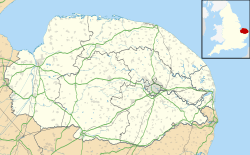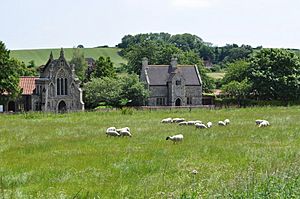Basilica of Our Lady of Walsingham facts for kids
Quick facts for kids Basilica of Our Lady of Walsingham |
|
|---|---|
| "Chapel of Saint Catherine of Alexandria" | |
|
"The Slipper Chapel"
|
|

Front entrance of the 14th-century Slipper Chapel
|
|
| 52°52′52″N 0°51′12″E / 52.88112°N 0.85331°E | |
| Location | Houghton Saint Giles |
| Country | England |
| Denomination | Catholic Church |
| Website | walsingham.org.uk |
| History | |
| Status | Active |
| Founded | 1340 |
| Architecture | |
| Functional status | National Shrine |
| Heritage designation | Grade I listed |
| Designated | 6 March 1959 |
| Architect(s) | Thomas Garner |
| Style | Gothic Romanesque |
| Administration | |
| Diocese | Diocese of East Anglia |
The Basilica of Our Lady of Walsingham' is a special Catholic church and a national shrine in Houghton Saint Giles, England. It is about one mile from the village of Walsingham. This important place includes the very old Slipper Chapel, which was built in 1340. It also has a newer building called the Chapel of Our Lady of Reconciliation, finished in 1982.
The Slipper Chapel was once known as the Chapel of Saint Catherine of Alexandria. It was the last stop for pilgrims on their way to the Walsingham Priory. In 2015, Pope Francis gave it the special title of a "minor basilica."
Since 1934, a respected statue of Our Lady of Walsingham has been kept at the Slipper Chapel. This chapel has been a main place for Marian devotion (praying to Mary) for Catholics. In 1954, Pope Pius XII officially crowned the statue. It is still a very popular place for people to visit on pilgrimages.
Contents
History of the Slipper Chapel
When the Slipper Chapel was first built, Walsingham was one of the most important pilgrimage sites in England. Only Canterbury was more popular. People came from all over the country and even from other places to visit.
In 1538, during the time of King Henry VIII and the English Reformation, the chapel was no longer used as a church. Over many years, it was used for different things, like a place for poor people, a metal workshop, a cowshed, and even a barn.
In 1863, a rich local woman named Charlotte Pearson Boyd found the chapel. She had recently become a Catholic. In 1896, she bought the building from the farmer who owned it. She then had it fixed up and gave it to Downside Abbey for Catholic worship. The chapel was repaired even more in 1904 by an architect named Thomas Garner.
In 1897, the church in King's Lynn was made the national shrine of Our Lady of Walsingham. This meant the statue there could be publicly honored. Then, in 1934, the statue was moved to the Slipper Chapel near Walsingham.
On August 15, 1934, Bishop Laurence Youens held the first public Mass in the Slipper Chapel in 400 years. Two days later, Cardinal Francis Bourne led a large pilgrimage. More than 10,000 people, including Catholic bishops from England and Wales, came to the shrine. From that day on, the Slipper Chapel became the official Catholic national shrine of Our Lady of Walsingham.
The Holy Mile Pilgrimage
Since the 1300s, the Slipper Chapel has been the last stop on the pilgrimage route. It's where pilgrims traditionally took off their shoes. They would then walk the last "holy mile" barefoot to Walsingham Priory. This is why it's called the 'Slipper' Chapel. Many pilgrims today still follow this tradition. They remove their shoes at the chapel and walk the final mile into Walsingham without them.
Modern Times at the Shrine
The Slipper Chapel holds a special wooden statue of Our Lady of Walsingham. This statue was made in Germany in the late 1800s. Pope Leo XIII blessed it in Rome. In 1982, the statue was taken to Wembley Stadium. It was placed on the altar during Pope John Paul II's visit to Britain.
Every year on September 8, which is the Feast of the Birth of Our Lady, the statue is carried several miles in a procession. This procession starts at the Slipper Chapel.
The area around the Slipper Chapel has grown. It now includes the Chapel of Our Lady of Reconciliation, which was finished in 1982. This chapel can hold up to 350 people for services. It can also open up to a larger pilgrimage area for bigger events. The site also has a picnic area, a gift shop, and a tea room.
In 2007, the Slipper Chapel was shown in a BBC TV show called How We Built Britain.
In 2018, the leaders of the Catholic and Anglican shrines signed an agreement. They promised to work together and pray for Christian unity.
The Statue's Special Crowning
On August 15, 1954, Pope Pius XII sent his representative, Monsignor Gerald O'Hara, to crown the statue of the Virgin Mary. This was done in the Pope's name. The money for the crown came from gold and jewels given by Catholic women from all over the country.
About 15,000 pilgrims came to the crowning ceremony. There was a special procession along the "holy mile" to the shrine. Monsignor O'Hara performed the crowning. During the event, two white doves landed on the statue's lap. Many people there thought this was a miracle.
American military people from a nearby air base helped with security for the large crowd. The Slipper Chapel was also a place of worship for Catholic chaplains and military staff from the United States Air Force stationed there.
Becoming a Minor Basilica
On December 27, 2015, Pope Francis gave the shrine the special title of a minor basilica. This was a big honor for the Catholic shrine of Our Lady of Walsingham.
Interior
-
The special statue of Our Lady of Walsingham that was crowned in 1954
See also
 In Spanish: Basílica de Nuestra Señora de Walsingham para niños
In Spanish: Basílica de Nuestra Señora de Walsingham para niños






